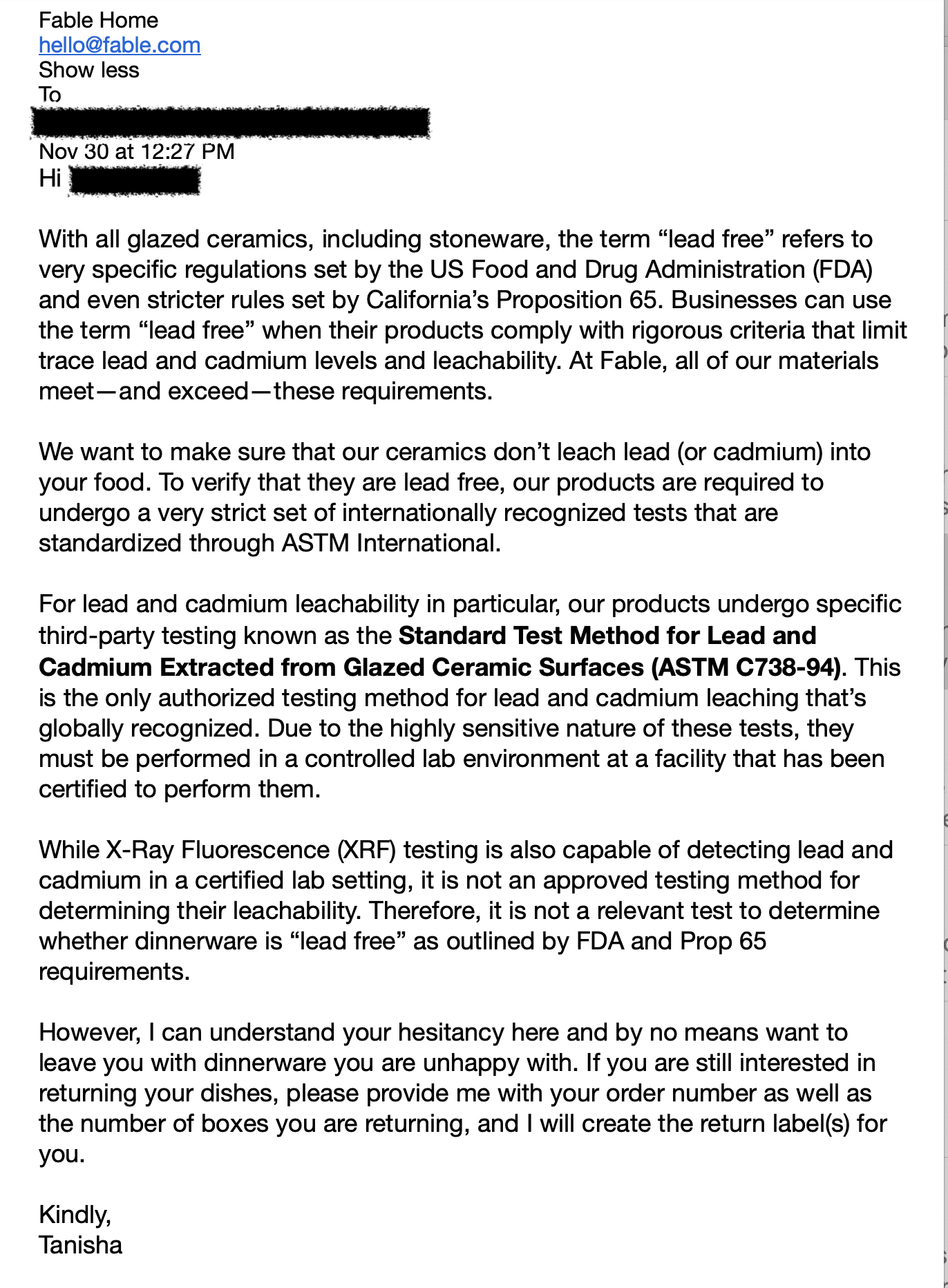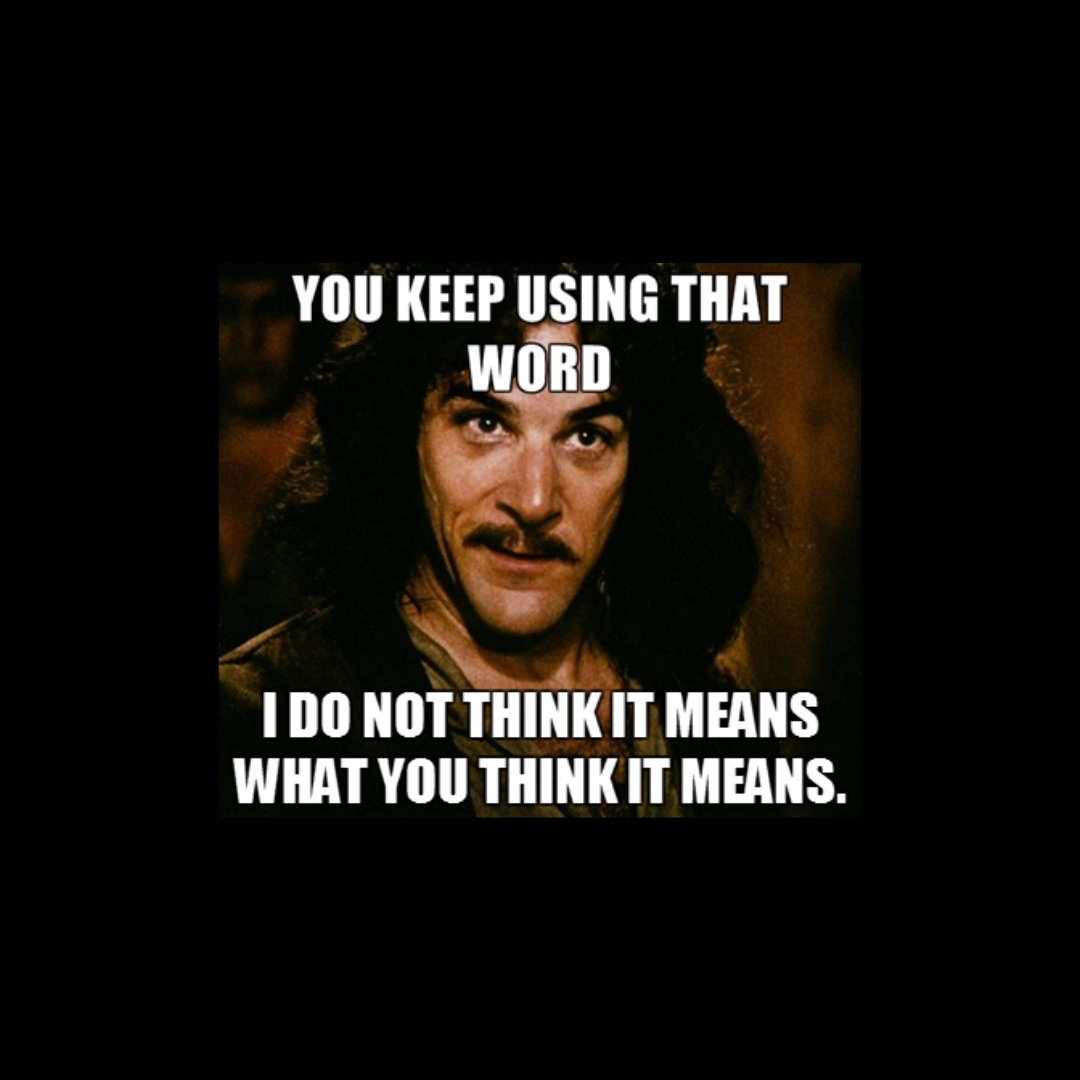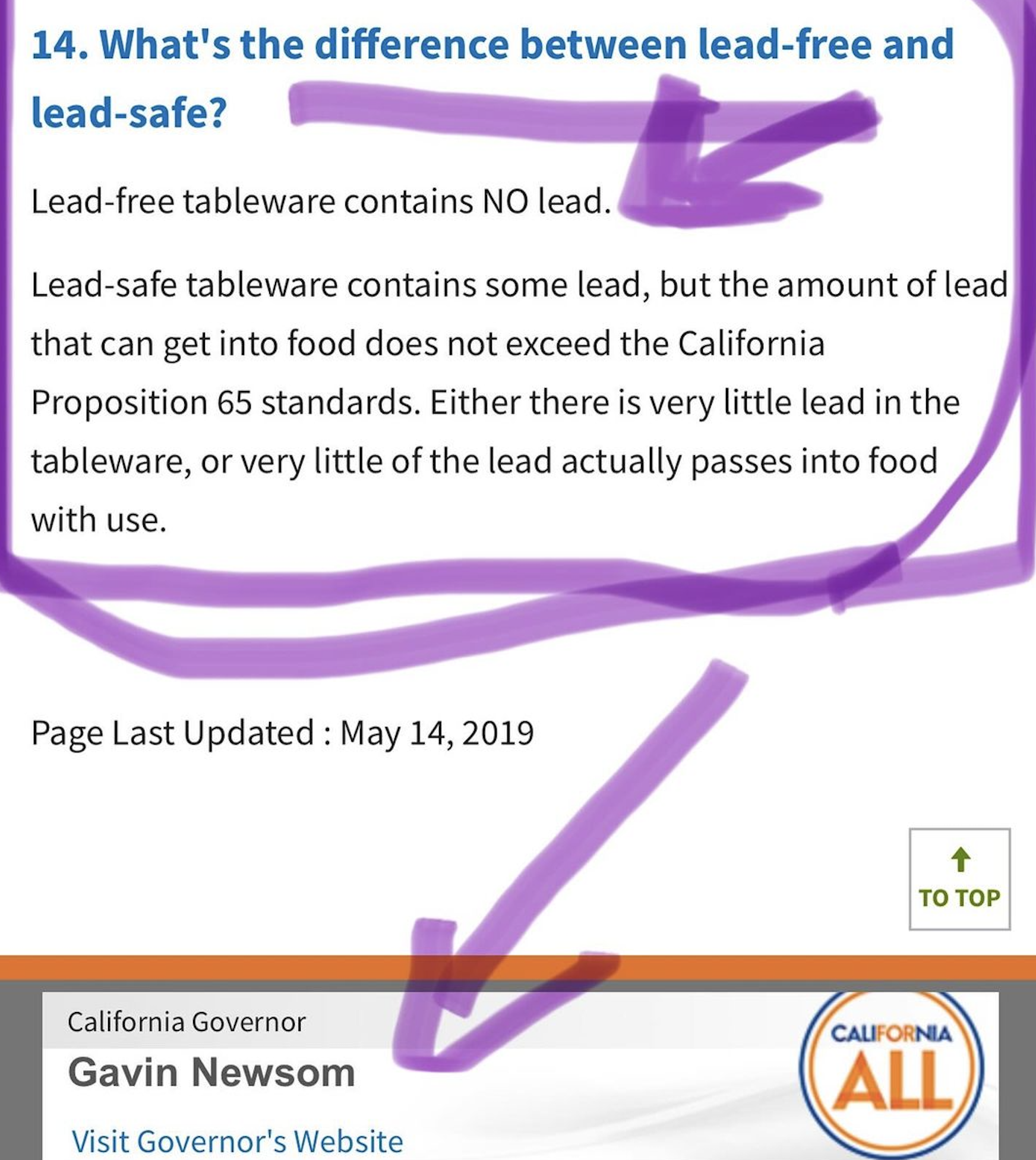As expected, Fable uses alternate definition of the term “Lead-free” to justify the presence of Lead (& Cadmium) in their dishes (which are advertised as “Lead-free”)
We currently have three articles published related to Fable dishware:
- Our initial article detailed the concerns and our test results from testing several examples of their products.
- A follow-up piece featured our email exchange with the owner of Fable (an effort to help him better understand the issue as it was clear he did not read — or did not understand the content of — our initial article).
- This piece (below) has Fable’s response to customers — (which is identical to the statement published on their website) — and some commentary from me.
This is an ad-free article.
We are publishing it as an ad-free article to make it easier to read, if you would like to make a contribution to help us keep our more widely-read articles ad-free, click here. Thank you!
For those new to the Lead Safe Mama website:
Tamara Rubin is a multiple-federal-award-winning independent advocate for childhood Lead poisoning prevention and consumer goods safety, and a documentary filmmaker. She is also a mother of Lead-poisoned children (two of her sons were acutely Lead-poisoned in 2005).
- Tamara owns and runs Lead Safe Mama, LLC — a community collaborative woman-owned small business for childhood Lead poisoning prevention and consumer goods safety.
- Since 2009, Tamara has been using XRF technology (a scientific testing method) using the exact instrumentation employed by the U.S. Consumer Product Safety Commission to test consumer goods for toxicants (specifically heavy metals — including Lead, Cadmium, Mercury, Antimony, and Arsenic).
- Since July of 2022, the work of Lead Safe Mama, LLC has been responsible for 5 product recalls (FDA and CPSC).
- All test results reported on this website are science-based, accurate, and replicable.
- Items that Lead Safe Mama, LLC reports on are tested multiple times to confirm the results published (for each component tested).
- Tamara’s work was featured in Consumer Reports Magazine in February 2023 (March 2023 print edition) and The Guardian in November 2023.
If you are a Fable customer, I would love for you to share your response to their statement below.
How do you feel about the fact that they use an alternate definition of “Lead-free” to justify the presence of Lead in their dishware that is marketed as Lead-free?
See the full email Fable is sending out to customers below.
If you want a full explanation of why this statement is corporate/ industry greenwashing and doublespeak, please read my original article about Fable (link here) or my overview piece on Lead in pottery and dishware (link here).
Is this what you expect when you pay premium prices for a Lead-free and Cadmium-free mug?

- I have not been able to locate a similar Prop 65 guidance document for using the term “Lead-Free” in reference to pottery — I don’t know that one exists. (If you find that document, please do share it with me!) UPDATE! I found it… Prop 65 (State of California) DOES NOT allow Fable’s use of the word Lead-free (as I expected!)
- Please note the FDA statement is a GUIDANCE statement for usage of the term, not a REGULATION (as stated in Fable’s email).
Another important point: XRF testing does NOT need to be done in a laboratory setting to be scientifically relevant, accurate, and replicable. Mobile XRF technology has specifically been designed for use in the field. It is true that XRF testing does not determine leachability, but instead determines actual TOTAL Lead (and Cadmium) content (in a coating or substrate) — and total content is 100% relevant for determining if something is ACTUALLY Lead-free (vs. linguistically “Lead-free”).
Note also: The total content levels of Lead found in the glaze of the examples of Fable pottery we tested were above their asserted/ implied/ noted “trace” levels — especially given the levels found in the glaze were higher than the levels found in the substrate (the substrate levels of Lead and Antimony that we found in Fable’s clay base would be considered “trace”).
The 90 ppm CPSC Limit (CPSIA 2008) for Lead in the paint, glaze, or coating of items intended for use by children supports this point (that the amount of Lead found in their glaze far exceeds “trace” levels). For context, the Cadmium levels found in the blush glaze could be considered trace levels.
- The range of Lead in the Substrate of the three pieces tested was:
- 30 to 83 ppm
- The range of Lead in the Glaze of the three pieces tested was:
- 169 to 259 ppm
- The range of Cadmium found in the blush glaze was:
- 6 to 28 ppm
- The range of Antimony found in the substrate of the one positive example was:
- 15 to 43 ppm
Here’s a link to a PDF of that FDA “guidance” (in case the link on the FDA’s site — above — disappears in the future at some point).
A key statement in the above-linked document (a document which only specifically applies to pottery imported from Mexico and other imported “traditional” pottery): “FDA’s guidance documents, including this guidance, do not establish legally enforceable responsibilities. Instead, guidances describe the Agency’s current thinking on a topic and should be viewed only as recommendations, unless specific regulatory or statutory requirements are cited. The use of the word should in Agency guidances means that something is suggested or recommended, but not required.”
Here’s the text version of the above letter (for those using a text reader or similar):
Hi <Customer Name>,With all glazed ceramics, including stoneware, the term “lead free” refers to very specific regulations set by the US Food and Drug Administration (FDA) and even stricter rules set by California’s Proposition 65. Businesses can use the term “lead free” when their products comply with rigorous criteria that limit trace lead and cadmium levels and leachability. At Fable, all of our materials meet—and exceed—these requirements.We want to make sure that our ceramics don’t leach lead (or cadmium) into your food. To verify that they are lead free, our products are required to undergo a very strict set of internationally recognized tests that are standardized through ASTM International.For lead and cadmium leachability in particular, our products undergo specific third-party testing known as the Standard Test Method for Lead and Cadmium Extracted from Glazed Ceramic Surfaces (ASTM C738-94). This is the only authorized testing method for lead and cadmium leaching that’s globally recognized. Due to the highly sensitive nature of these tests, they must be performed in a controlled lab environment at a facility that has been certified to perform them.While X-Ray Fluorescence (XRF) testing is also capable of detecting lead and cadmium in a certified lab setting, it is not an approved testing method for determining their leachability. Therefore, it is not a relevant test to determine whether dinnerware is “lead free” as outlined by FDA and Prop 65 requirements.However, I can understand your hesitancy here and by no means want to leave you with dinnerware you are unhappy with. If you are still interested in returning your dishes, please provide me with your order number as well as the number of boxes you are returning, and I will create the return label(s) for you.Kindly,Tanisha
Never Miss an Important Article Again!
Join our Email List












Hi Tamara – Thanks for posting this. Here is their website page for their “reports” on this that I received today. You probably already saw it, but sharing it just in case. Would love to know your thoughts and whether I should push to return my products from Fable – I have a ton of their stuff and have been using it for a couple years. They didn’t offer me a “return” option like the email posted above. Maybe because my stuff is older?
Sorry! forgot to put the link I mentioned in my comment – https://fable.com/pages/product-testing-reports
Sorry for multiple comments, but this is so upsetting. Here are two blog articles on the Fable website that discuss the dangers of lead and cadmium in dinnerware. They explicitly claim that there is “no lead and cadmium.” Not sure how they can now essentially say – “Just kidding! we meant that there is lead and cadmium, we just pass the basic leach requirement.”
https://fable.com/blogs/nest/lead-free-dinnerware
https://fable.com/blogs/nest/ultimate-guide-to-dinnerware
Yikes! Mistakes do happen. I can’t understand why some can’t realize they made a mistake and then fix it.
The right response would be a call for recall. It will do the same thing as they just did, allow customers to return their dinnerware. And at the same time, build brand credibility in the long run. I would’nt mind buying stuff from a company that made a mistake in the past, as long as they did a recall and fixed it.
This crappy PR spin helps nobody, especially fable.
Thank you for commenting!
T
Especially given that Tamara explained to them very clearly how to go about taking responsibility and turning this situation around to their own benefit (and the benefit of their customers). It’s beyond ridiculous, all these companies are just total bs when you actually look behind the flashy curtains. Makes me want to produce my own line of dishes and cookware that are actually toxin free!
THIS!
Can you explain or do you know why the government doesn’t use the XRF testing to determine lead content? I want to make sure I’m understanding correctly. So the testing that Fable has done is just to see if any lead is leaching out of the glaze or substrate itself like it would with regular wear and tear of someone’s dishes, and the XRF testing can tell if there is ANY Lead or Cadium in the piece at all, is that correct? So obviously with the plates you can recommend, if the XRF testing found NO lead or Cadium at all, then nothing can be leached with regular use because it’s simply not there. I don’t understand why the government and businesses wouldn’t want to use the test that actually shows if there is any lead at all.
Thank you for your ongoing work. I have gotten rid of my dishes and have bought new ones based on your recommendations and test results.
Thank you – yes – correct assessment. The government regs protecting children DO use XRF testing because the government regs protecting children are concerned with total content – not just leaching (because that is protective of human health.)
It is explained also in the overview article: https://tamararubin.com/2023/11/popular-canadian-fable-dishware-sold-as-non-toxic-and-lead-free-tests-positive-for-lead-in-the-glaze-read-more-here/
Thanks for commenting!
T
I feel very frustrated. I bought these plates a year ago, in the slow process of getting ‘better for you’ stuff. I got fable plates and water glasses. The plates chip like no bodies business.. so does that mean the plates that are chipped are more likely to spread the lead and other stuff?
Feeling defeated….
Side note, I just bought 360 cookware pans. have you done these? I live in Canada so it cost a nauseating amount.
Thanks for taking the time to read this and respond.
Also how do I even go about the wording of an email to a company like fable?
It appears that they are offering refunds if you return the products. You might want to just be in touch with them (email the owner at his email in the earlier article) and tell them you bought them because you thought they were “100% toxin free” as advertised and you didn’t realize they were applying language from a regulatory loophole to justify the scientifically verifiable Lead-content of their dishes and you would like a refund.
I have not yet tested 360 ware.
T
Thank you so much for replying.
Can I send you a 360 lid? Would that suffice or do you need the pan?
Thanks
I Googled the name of the founder of Fable (Joe Parenteau) and it looks like he used to live in Canada but now lives in ANDORRA. Andorra = tax haven. It makes my blood boil knowing how much PROFIT he is making by selling a lie (selling a dangerous fable if you must) and harming all these families.
Dear Tamara,
I truly appreciate your work. I have been reading up on your articles and simultaneously going through my kitchen and boxing up items that likely contain lead. Some of these items are very costly and it is a financial hit to get rid of and replace with safer cookware. I was wondering if you had any advice on whether/how to confront these companies (hoping for a refund). I’d appreciate any input you have.
All the best!
Hello again,
I just saw a similar question above that you answered but I’d still appreciate any other input you have. I understand you’re busy! 🙂
Does anybody know of a dishware set I can purchase that IS totally lead free? Or is the only way to purchase and self test? It’s been very difficult finding a company made in USA that guarantees no heavy metals. Thanks for any and all advice!
Where can I be confirmed that there is no lead and no cadmium in malacasa porcelain dishes?
Hello – really appreciate your awareness on this. I was just about to purchase Fable dishware and am now reconsidering. Do you have any recommendations for brands that are actually toxin free? Thanks in advance!
While many brands may use lead-free glazes, lead-free ceramics are rare. We recommend using clear glass dishes – some suggestions here: http://www.ShopLeadSafeMama.com